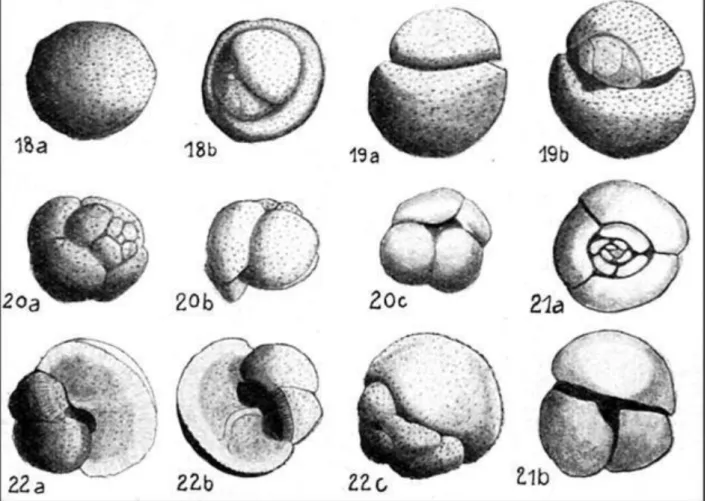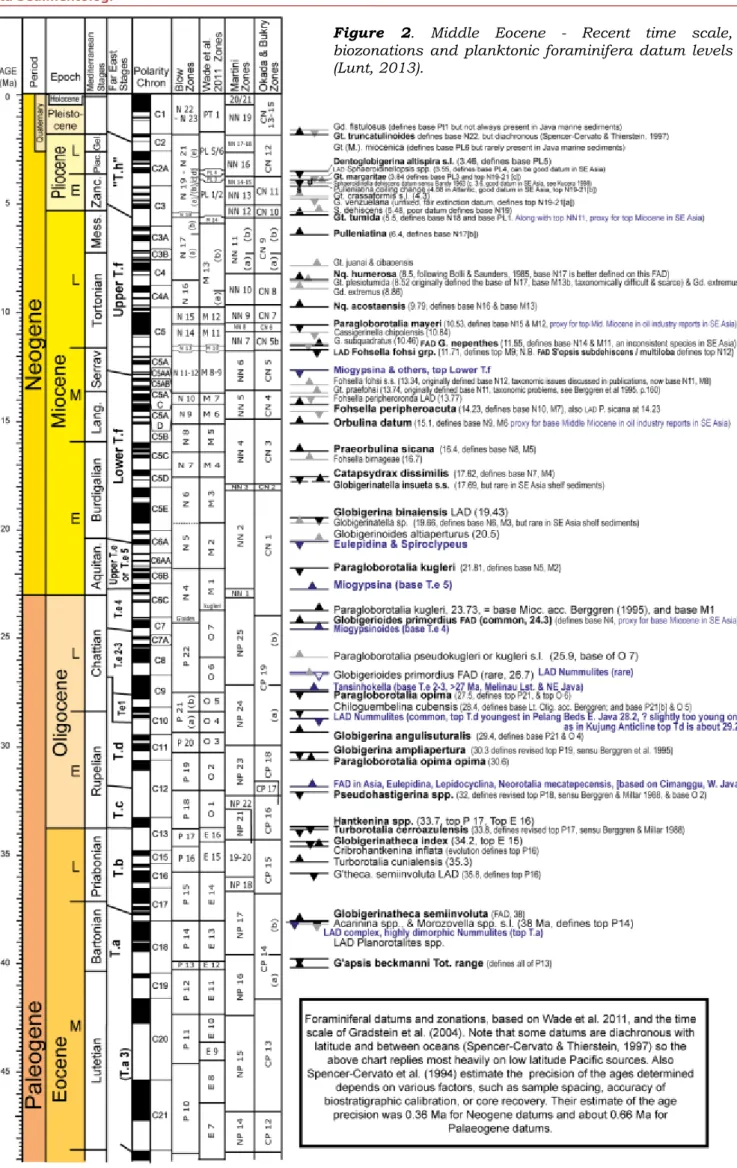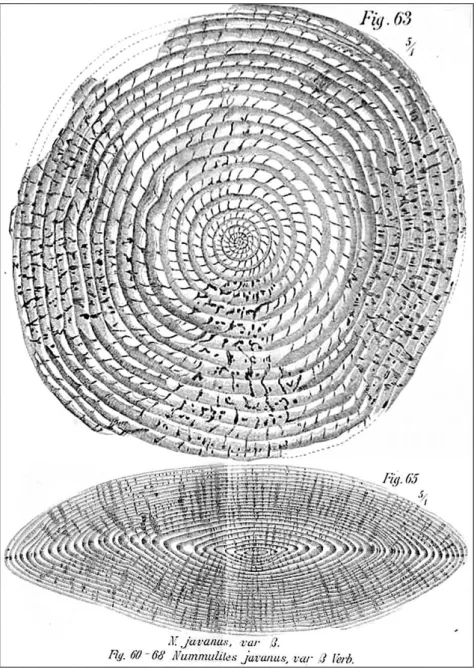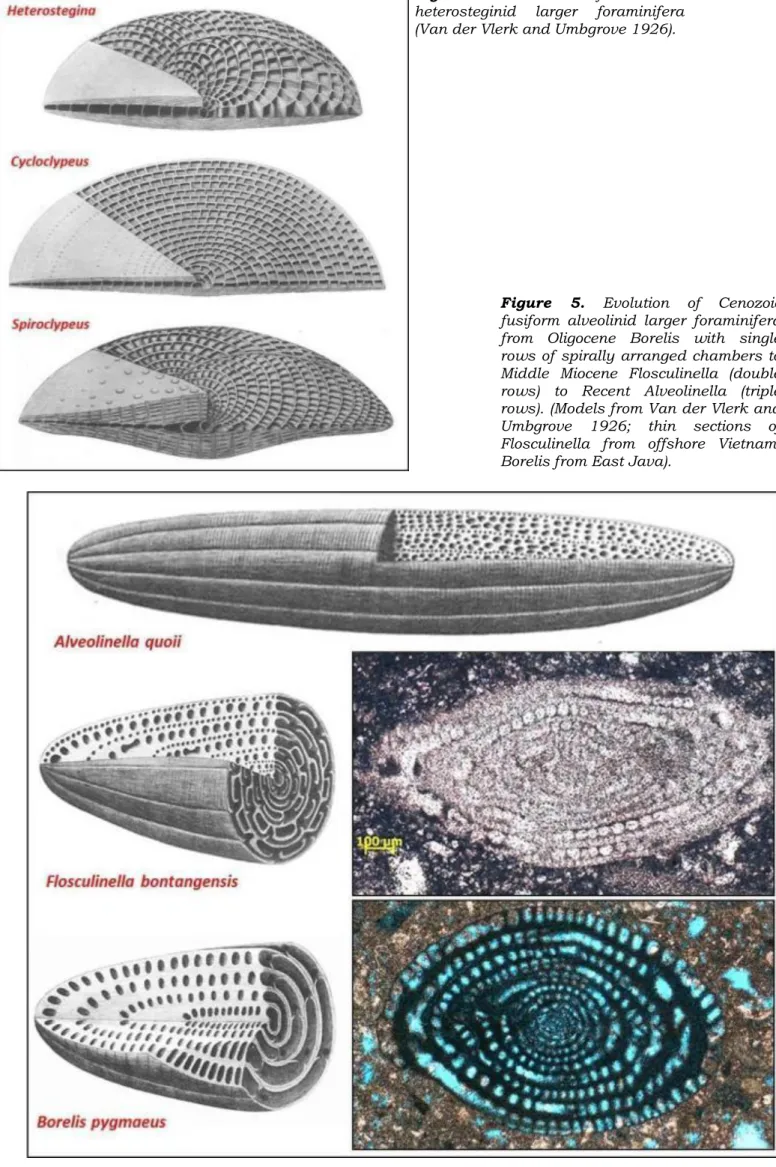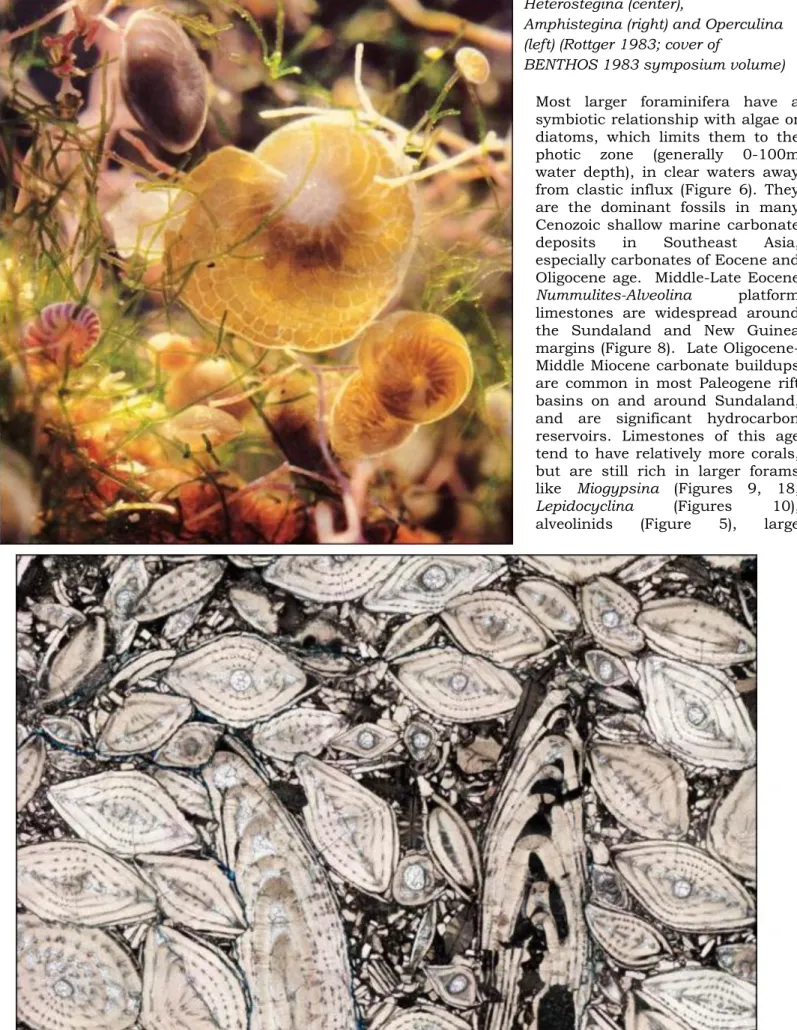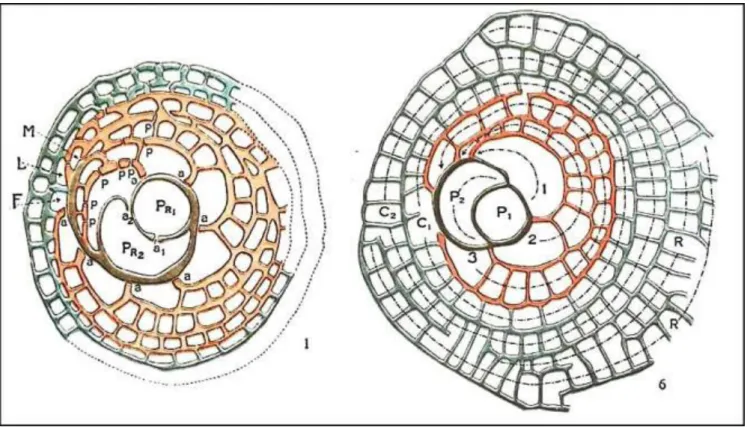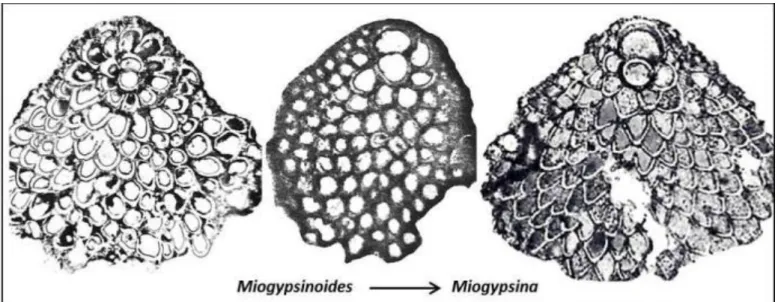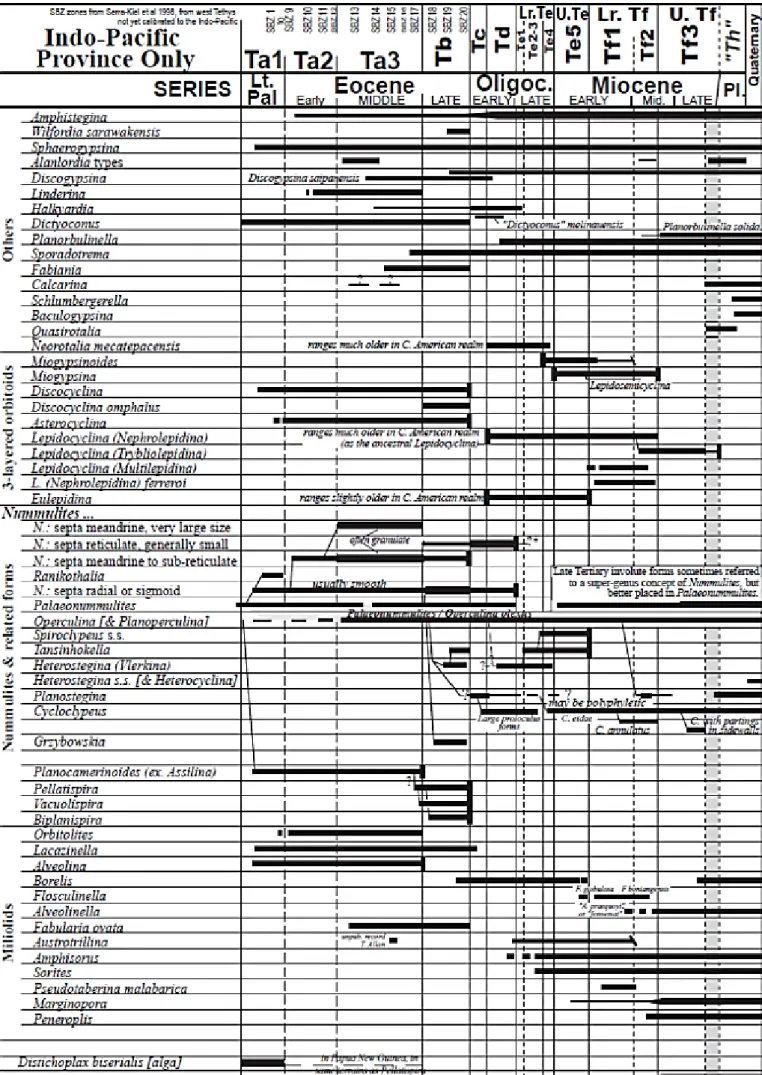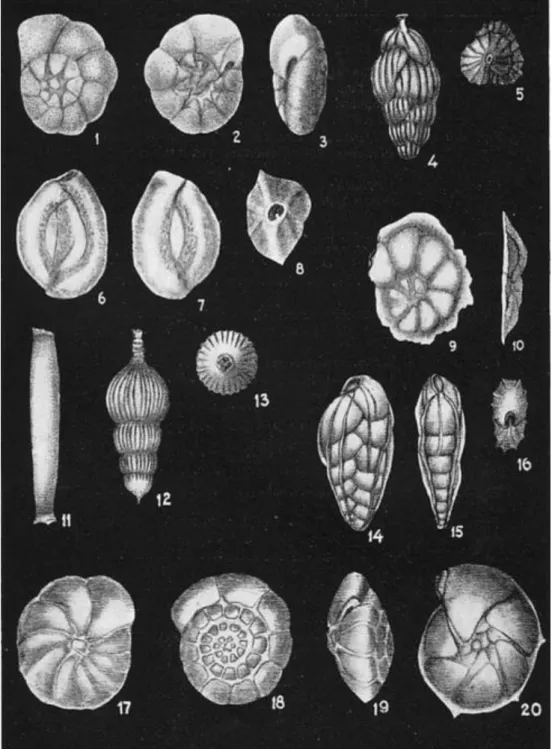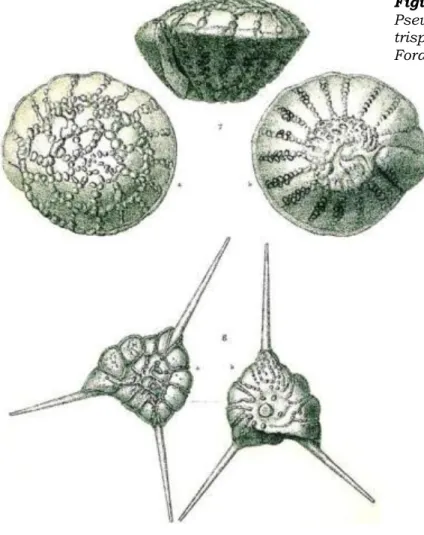Page 6 of 134 Number 29 – April 2014
Introduction to Cenozoic biostratigraphy of Indonesia- SE Asia
J.T. (Han) van Gorsel1, Peter Lunt2 and Robert Morley3
1 Houston, Texas
2 Mitra Energy Ltd, Kuala Lumpur
3 Palynova Ltd, Littleport, Cambs UK
ABSTRACT
An overview is presented of the current 'tools' of biostratigraphy and biofacies interpretation, as applied in the Cenozoic basins of Indonesia and Southeast Asia. We discuss previous work and historic developments of the biozonations and biofacies significance of the principal microfossil groups used in the region (foraminifera, calcareous nannofossils, palynology) and present the latest zonation charts and tables of key references. Brief reviews of work done on ostracodes, diatoms and radiolaria are also included.
INTRODUCTION
Studies of fossils are one of the most important tools for the study of sedimentary rocks and basins. First, the succession of evolutionary appearances and extinctions provides age control, which is critical for understanding of basins evolution and validation of geological concepts. Second, fossils are useful for interpretation of local paleoenvironments and paleoclimatic settings, by comparing them to modern analogs whose environment parameters are known.
Gradual or sudden temporal changes in depositional setting must follow Walther’s Law and can therefore differentiate between normal sequential deposition and breaks at the larger sequence boundaries. Also, the geographical distributions of fossils allow the reconstructions of paleobiogeographic provinces.
Due to the small size of available sample material from petroleum exploration wells, microfossils (foraminifera, calcareous nannofossils) and palynomorphs (mainly spores and pollen) have become the tool of choice in the oil industry for interpretation of sedimentary geology of the Cenozoic basins of SE Asia. Their abundance, compared to macrofossils, provides more robust, or at least more consistent, data.
The best stratigraphic sections across sedimentary basins are generally in petroleum exploration wells.
Unfortunately, virtually all results of biostratigraphic analyses of these wells remain proprietary and reside in the archives of service companies such as CoreLab, Geoservices, Robertson and other consulting groups. Despite their wealth of cumulative experience and unique data access, they have a remarkably poor record of publishing results or contributing to improvement of biostratigraphic tools in Indonesia in the last 30 years of their existence.
However, there is still much published literature is available on the biostratigraphy and paleontology of Indonesia and surrounding Southeast Asia. A comprehensive reference list of over 3200 papers on Paleozoic- Recent biostratigraphy and paleontology of Indonesia (or papers with significant biostratigraphy content) was selected from the 'Bibliography of the geology of Indonesia and
surrounding areas' (online at:
www.vangorselslist.com) and will be attached to this issue of Berita Sedimentologi 29.
Much of the biostratigraphic-paleontological literature is quite old, some going back 150 years, but since these old papers tend to be descriptions of fossils and rocks rather than discussions of models and hypotheses, these are still valuable today, especially for remote regions that have not been revisited. The oldest papers on biostratigraphy of indonesia focused on macrofossils from outcrops.
For the Cenozoic these are mainly on bivalve and gastropod mollusks, and the percentage of living species was long used for relative age determinations (Martin 1897-1937). Brief reviews of Cenozoic and Paleozoic-Mesozoic macrofossils of Indonesia are planned for future issues of this journal.
General papers on micropaleontology of Indonesia/
SE Asia include Billman and Scrutton (1976), Van Gorsel (1988), A. Kadar et al. (1996), Van Borren et al. (1996), Simmons et al. (1999) and Lunt (2013a,b).
Palynological methods were summarized by Morley (1978, 1991, 1996). Much is of this review was taken from these papers. Most of this paper focuses on calcareous microfossils and palynomorphs, but it also includes brief overviews of siliceous microfossils. Tables 1-4 list the key references of the biostratigraphy and biofacies of the various fossil groups. With a few exceptions, these tables do not include papers from outside Indonesia, which are listed in the separate Bibliography.
Page 7 of 134
Berita Sedimentologi BIOSTRATIGRAPHY OF SE ASIA – PART 1
Number 29 – April 2014
MICROFOSSIL GROUPS
The three fossil groups routinely used for dating of Cenozoic sediments of Indonesia/ SE Asia are foraminifera, calcareous nannofossils and palynomorphs. Another dating technique is the use of Strontium isotope stratigraphy (SIS) for limestones and calcareous fossils. Each has weaknesses and strengths, and each must be evaluated fairly with respect to the other.
Best age resolution is obtained by integrating the results of multiple microfossil groups:
(1) and (2): Planktonic foraminifera and calcareous nannofossils are the key tools in open marine deposits. In shallow marine sediments or in very small samples calcareous nannofossils often have better recovery and therefore better zonal resolution.
In outcrop samples, larger samples may yield adequate numbers of foraminifera and they become a better age dating tool, with the advantage that there is more paleoenvironmental information in the composition of the planktonic and benthic foraminiferal faunas.
(3): Complex larger foraminifera are the principal fossils in shallow marine carbonates, where there are usually no or few planktonic foraminifera, nannofossils or palynomorphs.
(4): Palynology is the principal tool in non-marine and marginal marine deposits.
Time Scales
Both nannofossil and foraminiferal zones have been calibrated to the absolute time scale (measured in millions of years) through what is termed a geo- magnetic polarity time scale (GPTS), and which was developed mainly from DSDP/ODP ocean floor cores.
The time scale used here is 'GTS04' of Gradstein et al. (2004) (Figure 3). This calibration to the numerical time scale is important for comparisons with strontium and radiometric isotopic ages. The paper of Wade et al. (2011) is the latest review of calibrations of ages of tropical planktonic foraminifera ages to the geomagnetic polarity and astronomical time scale.
1. Planktonic Foraminifera
Planktonic foraminifera (Figure 1) are probably the best studied and understood, partly due to work on the deep ocean floor cored sections of DSDP/ ODP wells in the 1960's- 1980's (unfortunately, the DSDP/ODP program never managed to drill any wells in Indonesian waters). However, much work done on outcrop sections and wells in Indonesia also contributed to the study of Cenozoic planktonic foraminifera and the development of the low-latitude biozonation. For instance, Koch (1926) described key new Late Oligocene- Early Miocene species Globigerina tripartita and Globigerina binaiensis from NE Kalimantan (Figure 1).
Figure 1. Early illustrations of Oligocene- Miocene planktonic index foraminifera from Bulongan, NE Kalimantan (Koch 1926; renamed in Koch 1935): 18= Orbulina universa (more likely Praeorbulina), 19=
Globigerinoides bilobata, 20= Globigerina quadripartita, 21= Globigerina triparta n.sp., 22= Globigerina binaiensis n.sp..
Page 8 of 134 Number 29 – April 2014
Figure 2. Middle Eocene - Recent time scale, biozonations and planktonic foraminifera datum levels (Lunt, 2013).
Page 9 of 134
Berita Sedimentologi BIOSTRATIGRAPHY OF SE ASIA – PART 1
Number 29 – April 2014
Former NPPM (Caltex) micropaleontologist LeRoy (1948, 1952) was the first to recognize the lowest occurrence of Orbulina universa as a good base Middle Miocene time marker in the upper Telisa Formation of the Kassikan section of Central Sumatra. Blow and Banner (1966) used LeRoy's material from the Lower Palembang Formation of the Kassikan section to first document the gradual evolution of the early Middle Miocene Globorotalia praefohsi- fohsi lineage (zones N10-N12; species originally described as Globorotalia barisanensis by LeRoy, 1939).
The paper by Bolli (1966) on the cored section of the BPM Bojonegoro 1 well in East Java was another milestone in the development of the global Miocene- Pliocene planktonic foraminifera biozonation. Other significant early case studies from Indonesia include papers by Hartono, Harsono, D. Kadar and others (Table 1).
The series of evolutionary lineages, and Cenozoic planktonic foraminifera zonation schemes based on these, have been summarized in the classic books by Blow (1969, 1979), followed with minor modifications by Bolli and Saunders (1985). The zonation scheme of Blow, with the convenient 'N' (Neogene; 20) zones and 'P' (Paleogene 23 zones) zones has been used by most workers in the oil industry and academia in SE Asia. The largely similar but 'competing' zonation of Berggren (1972, Wade et al., 2011), with its P (Paleocene), E (Eocene), O (Oligocene), M (Miocene) and Pl (Pliocene) zones, has not found many followers in SE Asia. This is mainly because most of the modifications of the earlier Blow zonation proposed herein were more applicable to the Atlantic Ocean area than the Indo-Pacific province. Figure 2 summarizes the current low-latitude zonations and datum levels of planktonic foraminifera applicable to Indonesia (from Lunt 2013).
Further refinement to the 'standard' zonations can be made when adding observations that reflect changes in global climate or regional changes in oceanographic patterns,such as changes in coiling directions of species of Globorotalia, Neogloboquadrina, Pulleniatina, etc. (Bolli & Saunders,1985) and climate-controlled events like incursions of cold water species (see Paleoclimate chapter).
2. Larger foraminifera
Larger foraminifera have relatively large, complex calcareous tests, generally 2- 5mm in diameter; some specimens of Cycloclypeus, Eulepidina and Nummulites may grow to 5 cm or more. They
comprise several taxonomically unrelated families (Figures 3, 4, 5). The common characteristics are large size, and oriented thin sections through the embryonic stage are generally required for determination of species or the degree of development within an evolutionary series. External features or random thin sections generally allow genus identification. Most genera can be identified in the field, using a hand lens.
By far the most publications on microfaunas in Indonesia are dedicated to larger foraminifera, with many classic works by Verbeek, Rutten, Van der Vlerk, Tan Sin Hok and Umbgrove, and with later work by Boudagher-Fadel, Lunt, Renema and others (see Table 1). Among the earliest descriptions of larger foraminifera from SE Asia are those from Late Eocene Nummulites limestones from SE Kalimantan, West Sumatra and Central Java (Verbeek (1871, 1892; Figure 3).
Figure 3. Large Middle Eocene Nummulites javanus (microspheric) from Nanggulan, Central Java (Verbeek and Fennema 1896).
Page 10 of 134 Number 29 – April 2014
Figure 4. Models of Cenozoic heterosteginid larger foraminifera (Van der Vlerk and Umbgrove 1926).
Figure 5. Evolution of Cenozoic fusiform alveolinid larger foraminifera from Oligocene Borelis with single rows of spirally arranged chambers to Middle Miocene Flosculinella (double rows) to Recent Alveolinella (triple rows). (Models from Van der Vlerk and Umbgrove 1926; thin sections of Flosculinella from offshore Vietnam, Borelis from East Java).
Page 11 of 134
Berita Sedimentologi BIOSTRATIGRAPHY OF SE ASIA – PART 1
Number 29 – April 2014
Figure 6. Living foraminifera Heterostegina (center),
Amphistegina (right) and Operculina (left) (Rottger 1983; cover of
BENTHOS 1983 symposium volume) Most larger foraminifera have a symbiotic relationship with algae or diatoms, which limits them to the photic zone (generally 0-100m water depth), in clear waters away from clastic influx (Figure 6). They are the dominant fossils in many Cenozoic shallow marine carbonate deposits in Southeast Asia, especially carbonates of Eocene and Oligocene age. Middle-Late Eocene Nummulites-Alveolina platform limestones are widespread around the Sundaland and New Guinea margins (Figure 8). Late Oligocene- Middle Miocene carbonate buildups are common in most Paleogene rift basins on and around Sundaland, and are significant hydrocarbon reservoirs. Limestones of this age tend to have relatively more corals, but are still rich in larger forams like Miogypsina (Figures 9, 18, Lepidocyclina (Figures 10), alveolinids (Figure 5), large
Figure 7. Thin section of limestone composed mainly of Middle Eocene (Ta3) Nummulites from Halmahera (from Lunt and Allan 2004). Shows both large microspheric and small megalospheric generations of same species. This lack of size sorting implies an in-situ assemblage.
Page 12 of 134 Number 29 – April 2014
miliolids, etc.
Larger foraminifera have been used in biostratigraphy in Indonesia for over a century, and are still the most useful group for age and environmental interpretations in carbonates, which generally contain very few planktonic foraminifera, nannofossils or palynomorphs. The famous Eocene- Recent 'East Indies Letter Classification' is a zonation scheme (zones Ta-Th) based on larger
foraminifera and in the youngest part originally also mollusks. It was first proposed by Van der Vlerk and Umbgrove (1927), refined by Leupold and Van der Vlerk (1931) and modified and expanded by Adams (1970), who was also accidentally responsible for demoting Letter Stages to biozones.
Calibration of the larger foraminiferal zonation to the geological time scale has improved significantly over time, first in the 1970's -1980's through correlations
Figure 8. Two stages of Miocene- Recent Cycloclypeus: In grey embryon (P1+P2), in red spirally arranged 'nepionic chambers', in blue annular chambers ('neanic stage'). On left central part of Cycloclypeus indopacificus with 7 nepionic chambers; on right more advanced C. cf. guembelianus with 3 nepionic chambers (Cijengkol, W Java) (from Tan Sin Hok 1932).
Figure 9. Larger foraminifera evolution, from primitive Miogypsinoides complanata on left (from Van der Vlerk 1959) trough Early Miocene Miogypsinoides dehaartii (Larat; Van der Vlerk 1924) to advanced Middle Miocene Miogypsina indonesiensis/antillea on right (Madura, Schipper and Drooger 1974).
Page 13 of 134
Berita Sedimentologi BIOSTRATIGRAPHY OF SE ASIA – PART 1
Number 29 – April 2014
of larger foram zones to planktonic foraminifera zones (Clarke & Blow 1969, Haak and Postuma 1975, Adams 1984, Chaproniere 1984) and later through Strontium isotopes. For the latest ranges and calibration of the Letter Classification to the modern GPTS time scales see Lunt and Allen (2004), Lunt (2013) or Figures 3 and 6 of this paper.
Indonesia has also been the birthplace of classic studies on evolution patterns of Cycloclypeus, Miogypsina and Lepidocyclina (Tan Sin Hok, 1932- 1939; later refined by Van der Vlerk and others;
Table 1).
The Early Oligocene- Recent evolution of Cycloclypeus from a Heterostegina ancestor by developing circular/ annular growth pattern late in its ontogeny was first documented by Tan Sin Hok (1932) in West Java. Through time this pre-annular growth stage becomes progressively shorter (Figure 8). Tan Sin Hok tried to show this transition was in a
series of saltations or steps, but his and subsequent data indicate a gradual trend in evolution, with occasional branches. This allows the grade of evolution to be used for biostratigraphy, but the existence of such slow and apparently directed evolution has long been a challenge to evolutionary theories based on macrofossils.
The Late Oligocene- Middle Miocene Miogypsina lineage also shows a gradual development from the ancestral rotalid species Neorotalia mecatepecensis to Miogypsinoides complanata with a long initial stage of spirally arranged chambers, followed by a gradual shortening of the initial series of spirally-arranged chambers, until in the Middle Miocene a symmetrical arrangement of chambers around the two- chambered embryon is reached (Figure 9; see also Lunt and Allan, 2004).
In Lepidocyclina, which migrated to SE Asia from the Americas in the Middle Oligocene, a gradual trend is observed in the relative size of the first two embryonic chambers. In the Oligocene the first two chambers are of similar size, in Miocene the second chamber becomes progressively larger, until, close to its extinction level near the end of the Miocene, the second chambers almost completely envelops the first chamber (Figure 10;
see also papers by Tan Sin Hok, Van der Vlerk, Van Vessem 1978, Lunt and Allan 2004). The terminology for these forms is based on Greek words for their shapes: “ïso-“ for equal-sized second chamber, “nephro” for kidney-shaped second chamber and “tryblio-“ for second chamber shaped like a cup of bowl.
Figure 11 summarizes the current knowledge of stratigraphic ranges of Cenozoic larger foraminifera and the resultant 'Letter Stage' zonation in the Indo-Pacific region (from Lunt 2013).
3. Smaller Benthic Foraminifera biostratigraphy Small benthic foraminifera are common in samples from all marine and marginal marine facies, and assemblages can be of very high diversity. About 2000 species and subspecies have been described, many of which are probably synonyms (Lunt 2013b).
Classic early taxonomic descriptions of modern benthic foraminifera are the monographs on material from the major oceanographic expeditions to the East Indonesia region, including the Challenger, Albatross, Siboga, Snellius I and Snellius II Expeditions (see Table 2). Other significant papers include those by Millett (1898-1904) and Loeblich and Tappan (1994) on foraminifera from the Timor Sea. The principal taxonomic works on Neogene benthic foraminifera in the region are papers by LeRoy (1939-1944; Figure 12), Belford (1966) and Whittaker and Hodgkinson (1979). For additional references see Table 1 and the Bibliography.
Figure 10. Evolution of Lepidocyclina embryonic chambers, from Van der Vlerk (1959).
Page 14 of 134 Number 29 – April 2014
Figure 11. Ranges of Cenozoic larger foraminifera and Indo-Pacific Letter Stage zonation (Lunt 2013).
Page 15 of 134
Berita Sedimentologi BIOSTRATIGRAPHY OF SE ASIA – PART 1
Number 29 – April 2014
Figure 12. Benthic foraminifera from the Early- Middle Miocene Telisa Fm, Central Sumatra (LeRoy 1939).
Smaller benthic foraminifera species in SE Asia tend have relatively long age ranges and these age ranges are also relatively poorly documented. The composition of benthic foraminifera assemblages has not changed much since the Miocene. In most instances highest and lowest occurrences of benthic species in a sedimentary section reflect changes in facies, rather than evolutionary appearance or extinction levels. Therefore their use in biostratigraphy age dating is limited; their main value is in paleoenvironment and paleobathymetric interpretations (see below).
In Indonesia between about 1930 and 1960 benthic foraminifera were used routinely for correlations between petroleum exploration wells by BPM, Stanvac and Caltex micropaleontologists. In the absence of good taxonomic studies paleontologists identified many of the species by numbers, such as
Rotalia 5 or Elphidium 8. Very little of this work has been published, and is no longer meaningful today. The papers by LeRoy (1939 -1944) were an early effort to introduce formal names for the Neogene foraminifera faunas of the oil- producing basins of Sumatra, Java and East Kalimantan.
Over short distances, correlations based on benthic foraminifera distributions were not unreasonable, but they were primarily facies correlations with no real age significance, and correlations across lateral facies changes were obviously very difficult.
Such benthic foraminifera zonations are no longer used.
One of the exceptions to the above 'rule' is the use of the evolutionary developments in Late Miocene- Recent larger rotaliid foraminifera. Rotaliids are common and dominant in delta front- prodelta facies, where planktonic foraminifera are absent or very rare.
Following initial work by Huang (1964) in Taiwan, a zonation based on Ammonia, Pseudorotalia and Asterorotalia species was proposed by Billman and Witoelar (1974) in the East Kalimantan region, and subsequently expanded by Billman et al. (1980) (Figures 13, 14). It was further documented from the more marine deposits of the NE Java basin and calibrated to planktonic foram zones by Soeka et al. (1980) and Kadar (1992). Figure 14 shows ranges and zones of the rotalid foram zonation. Problems with this zonation include: (1) the taxonomy of this group still seems somewhat poorly defined, and (2) the ranges of some of the marker species may be partly facies-dependent (Whittaker and Hodgkinson, 1979).
Other examples of smaller benthic foraminifera that do have limited age ranges in Indonesia include (1) Neorotalia mecatepecensis, which is the ancestral species of the Miogypsinoides- Miogypsina larger foraminiferal lineage and is common in many of the Late Oligocene carbonates of Indonesia, and (2) Sigmoilina personata in the Late Eocene (Mohler 1946, Jamas and Luwarno 1982; see Figure 15).
Page 16 of 134 Number 29 – April 2014
4. Calcareous Nannofossils
Calcareous nannofossils are minute calcite platelets that cover unicellular pelagic marine algae (coccolithophorids), and are common in low latitude open marine deposits. Because most of the taxonomic work on was done in the last thirty years, by relatively few workers, this group does not have the taxonomic confusion that existed among some of the foraminifera taxa.
Nannofossils have an advantage over planktonic foraminifera in that they may be found in larger numbers closer to shore, more specimens can be extracted from smaller samples (e.g. side-wall cores), and sample processing is relatively easy. They are relatively simple structures, so identification is relatively easy, although the often subtle differences between species do require some operator experience. On the negative side, due their small size they require high-powered optical microscopes and samples are prone to contamination, both from contaminated lab equipment and from geological reworking.
Figure 14. Biozonation of Miocene- Recent rotaliid benthic foraminifera (Billman, Hottinger and Oesterle, 1980). Ammonia ikebei was renamed Ammonia togopiensis by Whittaker & Hodgkinson (1979).
Figure 13. Recent 'prodelta' benthic foraminifera Pseudorotalia schroeteriana (top) and Asterorotalia trispinosa (bottom) (from Brady 1884, Challenger Foraminifera).
Page 17 of 134
Berita Sedimentologi BIOSTRATIGRAPHY OF SE ASIA – PART 1
Number 29 – April 2014
Although some of the earliest pioneering work on nannofossils was done in Indonesia (Tan Sin Hok, 1927; Figure 16), little research work has been done on this group in Indonesia since then. The routine use of this group for age dating of oil well
samples from Tertiary basins in Indonesia started in the mid-1970's.
The most widely used nannofossil zonation in the low-latitude Cenozoic is largely based on the work of Martini (1971). It has a resolution similar to that of planktonic foraminifera, and integration of both tools typically provide a higher stratigraphic resolution. The Martini zones are numbered in a similar fashion as used in planktonic foraminifera: Neogene zones NN 1-21 and Paleogene zones NP1-25.
Another frequently used zonal scheme is that of Okada & Bukry (1980), using similar zones, but numbered with 'CN' and 'CP' prefixes. Varol (l983) proposed another slightly modified scheme for the Miocene- Recent in Southeast Asia. Figure 17 summarizes the current low-latitude zonations and datum levels of calcareous nannofossils applicable to Indonesia (from Lunt, 2013).
In the petroleum basins of Western Indonesia open marine facies with diverse nannofossils can be rare. Prodelta shales may yield only impoverished, Discoaster- dominated nannofossil assemblages. For this reason Lambert and Laporte-Galaa (2005) proposed a modified Miocene nannofossil zonation for the Mahakam Delta area, based on species of the Discoaster group only.
5. Ostracodes
Ostracode fossils are the calcareous valves of a class of small crustaceans. Although found in a wide variety of marine and non- marine environments, ostracodes have been much less studied than foraminifera, and are not routinely used in SE Asia
biostratigraphy. This is partly because they are usually associated with
more numerous
foraminifera, partly because there are very few ostracode specialists.
Stratigraphic ranges of ostracode species appears to be relatively poorly documented and many of the Cenozoic species appear to be long- ranging (e.g. Guernet, 1993).
The outer shells of ostracod species may vary between relatively thin, smooth types or thicker and highly ornamented varieties. Both types occur in brackish and marine environments, but smooth types appear to be relatively more common in lower salinity settings.
Figure 17. Middle Eocene- Recent time scale, biozonations and calcareous nannofossil datum levels.
Figure 15. Small benthic foraminifera Sigmoilina personata from SE Kalimantan, a marker species for Late Eocene (Mohler 1946).
Figure 16. Calcareous nannofossils of Discoaster group from Plio-Pleistocene of Roti and Timor, from the pioneering study of Tan Sin Hok (1927).
Page 18 of 134 Number 29 – April 2014
Figure 17. Middle Eocene- Recent time scale, biozonations and calcareous nannofossil datum levels.
Page 19 of 134
Berita Sedimentologi BIOSTRATIGRAPHY OF SE ASIA – PART 1
Number 29 – April 2014
The first paper on fossil ostracodes in Indonesia is by Fyan (1916) from the Pliocene of Timor (Figure 18). The most comprehensive study is by Kingma (1948), who described 94 species of Late Cenozoic ostracodes from North Sumatra, the Bojonegoro 1 well and Kendeng zone in East Java, as well as 20 Recent species from the Java Sea. Series of more recent, smaller papers by LeRoy (1939-1945; Figure 19) and Keij (1953-1979) are also of interest. A review of studies and extensive listings of recent and fossil ostracode species described from SE Asia is by Hanai et al. (1980). For papers on Recent species and distributions see Carbonel et al. (1987, 1988), Dewi (1993-2008), Mostafawi, Titterton et al. and others (see Table 1 and the bibliography).
6. Diatoms
Diatoms are photosynthetic single-celled algae that build intricate siliceous tests. Some species are benthic forms, others led a planktonic existence, but, being dependent on light, all lived within the photic zone. They are present in a broad range of environments, from fresh water deposits to marginal marine and pelagic oceanic environments. Many taxa have near-global distributions across multiple climate zones.
Diatoms are an important part of marine plankton worldwide, but are generally rare in most 'normal' marine sediments in Indonesia. They are more dominant in higher latitudes, while low latitude pelagic oozes are generally dominated by planktonic foraminifera and calcareous nannofossils. However, diatomites or diatomaceous earths (composed mainly of diatom tests) may also form in low latitudes in areas of diatom algal blooms, which, in open marine environments, are generally associated with cold-water upwelling zones. For example, accumulations of the large marine diatom Ethmodiscus rex have been documented in Pleistocene glacial intervals in deep marine cores in the Indian Ocean off Sumatra (DeDeckker & Gingele 2002) and further West (Broecker et al. 2000), and also in the Equatorial Pacific and Atlantic Oceans.
These represent times of increased salinity and supply of silica to the oceanic surface water.
Quaternary lacustrine diatomites are known from the Lake Toba area in Sumatra (Samosir Island; Van der Marel 1947) and from Central Java (Darma area, Grandjean
& Reinhold 1933; Kalioso, Sangiran, Reinhold 1937) and East Java (Upper Kalibeng Fm near Kabuh, Krian in Kendeng zone). Such lacustrine deposits are commonly associated with volcanic tuffs that provided the silica source.
The distributions of modern marine diatoms in East Indonesia deep water samples was studied by Van Iperen et al.
(1993). Horton et al. (2007) described modern diatom distribution in mangrove swamps of the Tukang Besi islands, SE Sulawesi.
Fossil diatom floras have been commonly used for biostratigraphic and paleoenvironmental interpretations in oceanic sections, like the Neogene of the Pacific Ocean (Burckle 1972, 1978), but there are very few studies from Indonesia.
The first and still most elaborate paper on Cenozoic diatoms from Indonesia is Reinhold (1937), describing 208 species and varieties of marine and lacustrine diatoms from the Neogene of Java (Figure 20). Other Figure 18. Pliocene ostracodes from Atambua, Timor (Fyan,
1916). 1-6: Nesidea spp., 7-9: Cytheridea, 10-11: Cythereis, 12-13: Loxoconcha australis, 14: L. alata, 15-16: Cytherella , 17: Paracypris.
Page 20 of 134 Number 29 – April 2014
examples of applications of
fossil diatom
biostratigraphic zonation include papers by Ninkovich and Burckle (1979), Siregar (1981) and Burckle (1982), also on Late Neogene Central and East Java material.
Even if originally common, the use of diatoms in biostratigraphy is limited by their relative susceptibility to dissolution ,both in the water column and under burial conditions. Dissolution of the opaline diatom tests is widespread below burial depths of about 600- 1000m (>40-50°C ; Opal-A to Opal CT transition), below which much of the diatom shells are converted to siliceous cement, which is the main cause of a shallow Bottom-Simulating Reflector (BSR) on seismic lines over deep water deposits. At greater depths all that remains of diatom tests is microcrystalline quartz in bedded cherts.
Diatoms may still be seen
occasionally in
micropaleontology samples from greater depths, but as pyritized discs only ('Coscinodiscus').
Recent experiments in Indonesia have shown the potential of producing biofuels from cultures of the marine diatoms (Nurachman et al. 2012), which underlines the potential importance of diatoms for marine algal hydrocarbon source rocks.
7. Radiolaria
Like diatoms, radiolara are not common in 'normal' marine sediments of the Cenozoic basins of Indonesia, and Cenozoic and Recent radiolaria have received very little attention here.
Figure 19. Middle Miocene podocopod ostracodes Thalmannia sumatrensis (left) and Cythereis holmani (right) from Central Sumatra (LeRoy 1939).
Figure 20. Diatoms from Late Miocene- Pleistocene of Central Java (Reinhold,
1937). 1-11, 13:
Coscinodiscus spp, 12, 15:
Cyclotella stylorum, 14, 16:
Entogonia formosa.
Page 21 of 134
Berita Sedimentologi BIOSTRATIGRAPHY OF SE ASIA – PART 1
Number 29 – April 2014
A larger body of work exists for radiolaria of Mesozoic age in the Indonesian- SE Asia region (Hinde 1902, 1908 and later work by Wakita et al., Jasin Basir, etc.). Also like pelagic diatoms, the siliceous radiolaria are most abundant in deep marine- oceanic deposits in areas of high productivity like upwelling zones.
The Bandung-based brilliant Indonesian paleontologist Tan Sin Hok, known for his pioneering work on calcareous nannofossils and evolutionary patterns on larger foraminifera in the late 1920's- 1930's, also did some of the earliest work on radiolarian faunas in Indonesia. However, his work on radiolaria was less successful, as Tan did not realize that the samples he analyzed for his Ph.D. Thesis (Tan Sin Hok, 1927) were not all of Late Neogene age, but were a mixture of Late Neogene and Jurassic- Cretaceous marls. Because of this he had come to the conclusion that there were no good index fossils among radiolarians, which is far from the truth. Tan (1927) diligently described 141 radiolarian species and varieties (138 new) from four
deep marine radiolarian-rich limestones from the Bebalain area of Roti island W of Timor. These samples were collected by his thesis advisor Brouwer, who had already described Jurassic- Cretaceous radiolarian-rich limestones from Roti in a 1920 paper. For some reason Tan wrongly assumed the Bebalain samples were of Late Tertiary age, similar to the associated Late Neogene samples from which he described new calcareous nannofossils.
Subsequent authors correctly recognized that most of these radiolarians were from the folded deep marine Jurassic-Cretaceous sediments that unconformably underlie the Plio-Pleistocene marls on Roti and Timor (Riedel 1952, 1953). Many of Tan Sin Hok's new species have since been reported from Late Jurassic-Early Cretaceous deep water sediments of the Argo Abyssal Plain (Baumgartner 1993), Tanimbar (Jasin and Haile 1996) and the SW Sulawesi Barru Complex (Munasri 2013).
One unfortunate result of Tan's confusion was his criticism of Hojnos in Von Loczy (1934) for identifying Late Jurassic- Cretaceous radiolarians in East Sulawesi, stating that radiolarians should not be used for such age conclusions, because "many of the species reported also occur in very young Neogene deposits of Roti!" (Tan Sin Hok, 1935, p. 32).
Riedel (1953) described 26 Neogene radiolarian species from true 'post-orogenic' Pliocene-Pliocene marly sediments from Roti (Brouwer Sample 178;
Figure 21), the presence of which Tan had mentioned, but not described in any detail.
Harting (1864) published some early descriptions of modern radiolaria species from the deep Banda Sea.
More recently, modern radiolaria abundances on the Banda Sea floor were studied by Van de Paverd (1989; peak abundances between 2000-4000m).
Radiolaria are a useful group for Mesozoic- Cenozoic biostratigraphy, but mainly of deep marine deposits.
Figure 21. Plio-Pleistocene Radiolaria from near Bebalain Roti Island (Riedel 1953, Plate 85).
1-Tricolocampe (?) polyzona, 2- Eucyrtidium elongatum peregrinum, 3- Pterocanium sp, 4-Lamprocyclas maritalis antiqua , 5-Zygocircus triquetrus, 6-?Bathropyramis woodringi, 7-Tripilidium cladopodium exiguum, 8-Calocyclas margatensis, 9-Lychnodictyum audax.
Page 22 of 134 Number 29 – April 2014
The principal biozonations for Cenozoic radiolaria are by Riedel and Sanfilipo (1978) and Sanfilipo et al.
(1985).
8. Palynology
Palynology is the study of microscopic organic-walled remains of plants and algae that are composed of material that does not dissolve in mineral acids.
They are collectively are known as palynomorphs and, in addition to pollen and pteridophyte spores, include moss and fungal spores, algal remains (including dinoflagellate cysts), foraminiferal test linings, plant cuticle and chitinous remains of insect skeletons.
Palynomorphs are generally abundant in Cenozoic sediments of Indonesia, except in limestones and tuffs, and are usually the only microfossils present in non-marine sediments. The principal groups in the Cenozoic of SE Asia which are useful in stratigraphy are spores and pollen grains from land plants (reflecting vegetation within a catchment), but the resting cysts of marine dinoflagellates, and also fresh-water algae are also useful.
The flora of SE Asia is very diverse, with more than 30,000 higher plant species recorded from the region.
These leave a fossil record of about 600 or so pollen and spore types. In most instances, pollen/spore types reflect taxonomic variation of plant occurrences at the generic level, but in some plant genera, each species can be identified. This is the case in three genera; Sonneratia, (a mangrove), Alangium (a swamp forest tree) and Stenochlaena (a climbing fern). Pollen of these three genera are all stratigraphically useful, with fossil pollen of Sonneratia being described as the pollen taxon Florschuetzia, Alangium as Lanagiopollis, and Stenochlaena as Stenochlaeniidites.
Many pollen types remain undescribed as fossil pollen, but can easily be
named after the extant genera of the Southeast Asian flora which produce the pollen. Where a pollen type is found in two or more extant taxa, the suffix
‘type’ can be added to show that it is not restricted to the named taxon. This suffix can be used at the species, genus or family level. Some examples of this usage are as follows:
- Sonneratia caseolaris pollen, derived from the species Sonneratia caseolaris only (also termed Florschuetzia levipoli as a fossil taxon);
- Stenochlaena milnei type spores are found in the two species Stenochlaena milnei and S. cummingii (also termed Stenochlaeniidites papuanus as a fossil taxon);
- Calophyllum pollen, found only in the genus Calophyllum;
- Lithocarpus type pollen, found in the two oak genera Lithocarpus and Castonopsis;
- Gramineae pollen, found only in the family Gramineae (sometimes termed Poaceae);
- Amaranthaceae type pollen, indistinguishable with the family Chenopodiaceae.
Figure 22. Some characteristic Cenozoic pollen and spores of stratigraphic value: 1) Palmaepollenites kutchensis, 2) Restionidites punctulosus, 3) Lanagiopollis regularis, 4) Retistephanocolpites williamsi, 5) Lakiapollis ovatus, 6) Proxapertites cursus, 7) Magnastriatites grandiosus, 8) Cicatricosisporites dorogensis, 9) Meyeripollis nayarkotensis, 10) Florschuetzia trilobata, 11) Florschuetzia levipoli, 12) Stenochlaenidites papuanus, 13) Dacrycarpus australiensis.
Page 23 of 134
Berita Sedimentologi BIOSTRATIGRAPHY OF SE ASIA – PART 1
Number 29 – April 2014
Many fossil pollen types, especially in the early Cenozoic, remain to be identified and it is uncertain from which plants they were derived and what their ecologic and stratigraphic distribution was.
Additional pollen types can be identified through the study of pollen of modern plants. There is a collection of pollen of some extant plants in the Herbarium Bogoriense (LIPI Research Center for Biology, Cibinong).
Palynomorphs generally withstand normal sediment diagenesis well, but become modified by katagenesis during deep burial to many thousands of feet (or equivalent heating), which will turn the palynomorphs black, making identification difficult.
Very few of the common Neogene pollen or spore types have well defined stratigraphic ranges (in the same manner as benthonic foraminifera).
'Traditional' palynological zones based on the ranges of pollen and spores, are therefore relatively long- ranging: there are six or seven zones which can be interpreted from the Neogene (Figure 23), where planktonic forams and nannofossils boast around 20 zones. However, quantitative analyses often allow higher resolution zonations at a basin scale, using abundance fluctuations that reflect regional climate trends and sea level fluctuations (e.g. Fig. 24; South China Sea basins example). Also, more than 14 zones are likely for the Eocene-Paleocene (Figure 25).
The first palynological biozonation for the Tertiary of SE Asia was developed by Shell palynologists Germeraad, Hopping and Muller (1968) and reviewed by Morley (1978). Zonations were further clarified by Morley (1991, 2004 and Yakzan et al 1996).
Additional case studies were published by Rahardjo et al. (1994) for Java (Figure 23) and Lelono (2012).
Subdivision of the Oligo-Miocene is mainly based on evolutionary changes in Florschuetzia and Stenochlaneidites. The pollen of the mangrove genus Sonneratia, which, as noted above, reflects pollen variation at the species level, provides an insight as to why there are so few zones based on pollen and spores. All of the pollen and spore types used for Neogene zonations reflect pollen variation at the species level, so Phyllocladus hypophyllus pollen (Phyllocladites palaeogenicus) distinguishes the Pleistocene, Dacrycarpus imbricatus pollen (Dacrycarpidites australis) first appears in the mid Pliocene; Stenochlaena milnei type pollen (Stenochlaeniidites papuanus) is restricted to the later Late Miocene and Pliocene, and species of Sonneratia and their precursors allow zonation of the Middle and Early Miocene. However, mangrove pollen tend to be absent in supratidal deposits, so the Florschuetzia zonation is of limited use in basins dominated by fluvial-alluvial sections, such as the onshore Tertiary basins of Thailand (Watanasak, 1990).
Figure 23. Eocene- Recent palynological zonation of Java (Rahardjo et al. 1994, in Lelono 2012).
Page 24 of 134 Number 29 – April 2014
Figure 24. ‘PR’ palynological zones applicable to the Malay Basin, Nam Con Son and parts of West Natuna Basins (Yakzan et al., 1996).
Figure 25. Paleogene palynological zonation (Morley 2013 Utrecht pollen and spore masterclass, unpublished).
Page 25 of 134
Berita Sedimentologi BIOSTRATIGRAPHY OF SE ASIA – PART 1
Number 29 – April 2014
Figure 26. Paleoenvironmental trends in smaller benthic foraminifera assemblages (from Lunt 2013).
Page 26 of 134 Number 29 – April 2014
Local higher resolution schemes have been developed as a tool for correlations, using (1) changes in relative abundances that reflect hinterland climate changes, for example as expressed in fluctuations in percentages of rainforest versus grasses or montane palynomorphs, and (2) identification of transgressions, which are typically reflected by peaks of mangrove pollen (Morley, 1996).
Examples of this type of quantitative biostratigraphy include Yakzan et al. (1996, Malay Basin; Figure 24), Carter and Morley 1996 (Early Miocene, Kutei Basin), Morley et al. (2003, Natuna basin), Morley et al. 2004 (Makassar Straits) and Lelono and Morley 2011 (Oligocene, East Java Sea). During the development of the Malay and West Natuna basin studies, it became clear that most Neogene quantitative palynological events reflect events relating to sequence stratigraphy, and are likely to be different in different areas. From that time onward, high resolution biostratigraphic frameworks involving palynology have been presented as sequence biostratigraphic studies (such as Morley et al., 2011, for the Nam Con Son Basin), rather than describing further localized zonations based on quantitative changes.
Some of the long term changes in floral composition reflect plate tectonic movements. Collisions such as those between Indian and Eurasian plates in the Eocene and of New Guinea with Eastern Indonesia in the Neogene allowed migrations of Indian and Australian floral elements into SE Asia (Morley, 1998, 2000). The position of the Early-Middle Eocene boundary is based on the appearance of elements of the Proto Indian flora, such as Palmaepollenites kutchensis (Harley and Morley 1995), Lanagiopollis spp (from Alangium) and Beaupreadites matsuokae (Morley 1998), and the appearance of Stenochlaena milnei type and Dacrycarpus imbricatus are related to the collision of the Australian Plate with SE Asia.
The development of a pollen and spore zonation for the Paleogene has been hampered by the scattered nature of Paleogene outcrops and limited representation in the subsurface. A zonation for the Paleocene and Eocene has been informally developed by Morley and presented as part of the course notes at the Utrecht Pollen and Spore Masterclass (2013).
This is summarized in Figure 24 and is based on the assimilation of ranges of taxa from the East Java Sea and Paternoster subsurface, from published data from Sarawak (Muller 1968), and from outcrops in the Tanjung Formation of SE Kalimantan (Witts et al. 2012) and Nanggulan (Lelono 2000) and Bayah Formations in Java. A full explanation will be published elsewhere.
In addition to plant spores and pollen, dinoflagellate cysts are often present in palynological preparations from marine sediments. While these are now the primary group used for Mesozoic biostratigraphy of the NW Australian margin and in Eastern Indonesia and also the mid- and high-latitude Cenozoic, they are of minor importance in Cenozoic sediments of SE Asia. Many marine successions, such as the deep
water Mahakam Delta, are virtually void of dinocysts. Their rarity may be due to the everwet climate, giving little need for dinoflagellates to encyst, or to a change to producing cellulosic, as opposed to sporopollenin cysts. A few preliminary case studies in the Eocene of Central Java by Matsuoka and Morgenroth (Table 2) do suggest potential utility in early Cenozoic marine sediments.
The distribution of dinocysts through the Neogene of NW Borneo has been presented by Besems (1993).
Tables 1 and 2 list significant papers on various aspects of Cenozoic microfossil biostratigraphy in Indonesia. The full list of references, including papers from surrounding regions, is in Chapter X of the 'Bibliography of the geology of Indonesia and surrounding areas' (Edition 5.1, March 2014; online at www.vangorselslist.com) or at the accompanying Bibliography of Biostratigraphy compiled from this.
THE USE OF MICROFOSSILS IN BIOFACIES ANALYSIS
Depositional Facies and Paleobathymetry interpretation
Different microfossil groups and species lived in different environments, and once the distributions of modern counterparts are understood, these can be used for interpretation of depositional environments.
For foraminifera this includes not only water depth of deposition, but certain species may also be indicative of substrate, salinity, oxygen levels and paleotemperatures of sediment deposits.
Foraminifera are the primary tool for facies analysis, particularly the benthic foraminifera. Today these are found from brackish coastal waters down to the deepest marine environments, and their environmental distributions are well documented in numerous studies.
Early studies of modern foraminifera distribution off Java were by LeRoy (1939) and Myers (1945).
Significant papers on distribution of foraminifera in deep waters of East Indonesia include Hofker (1978) on foraminifera from the 1929 Snellius I expedition, Frerichs (1970) on samples from the Andaman Sea and Van Marle (1988, 1991) on foraminifera from the Snellius II expedition. Among recent case studies on the distribution of foraminifera in the waters of the Indonesian archipelago are papers by Adisaputra, Barmawidjaya, Rositasari, Suhartati Natsir, etc..
For listings of papers on distributions of modern foraminifera in the waters of Indonesia and surrounding regions see Tables 3 and 4 and the Bibliography.
Figure 26 depicts the major trends in distribution of modern foraminifera in Indonesia and nearby waters. These include (1) increase in diversity from marginal marine to a maximum in deep shelf- upper slope environments, (2) increase in percentage of planktonic foraminifera with water depth from 0% in marginal marine to >80% of fauna in bathyal
Page 27 of 134
Berita Sedimentologi BIOSTRATIGRAPHY OF SE ASIA – PART 1
Number 29 – April 2014
Table 1. Various references on Cenozoic foraminifera biostratigraphy settings, and (3) decrease in calcareous species
below about 2000-3000m where dissolution of calcareous tests starts to become significant
(calcareous tests are sometimes subject to dissolution at much shallower depths adjacent to major deltas).
T TABLE 1 CENOZOIC FORAMINIFERA BIOSTRATIGRAPHY
FAUNA/FLORA AREA REFERENCES
General Indonesia Billman & Scrutton (1976), Van Gorsel (1988), Lunt (2013a,b) Neogene
planktonic foraminifera
General Blow (1969, 1979), Kennett & Srinivasan (1983), Bolli &
Saunders (1984)
Java Bolli (1966), Blow & Banner (1966), Van der Vlerk & Postuma (1967), Hartono (1960, 1969), Harsono P (1968, 1983), Blow (1969, 1979), Wibisono (1972), Kadar (1972- 2008), Saint-Marc &
Suminta (1979), Van Gorsel & Troelstra (1981), Harsono et al.
(1998) West Papua/
PNG
Belford (1962, 1966, 1967, 1984, 1988)
Sumatra LeRoy (1948, 1952), Blow & Banner (1966), Kadar et al. (2008) Andaman Sea Frerichs (1971)
Paleogene planktonic foraminifera
Kalimantan Thalmann (1942), Baumann (1972)
Java Hartono (1960, 1969), Purnamaningsih Siregar & Harsono P.
(1981)
West Papua Belford (1966, 1974, 1989) Larger
foraminifera-
General Douville (1905-1924), Mohler (1946), Adams (1965-1992), Lunt (2003), Lunt & Allen (2004), Renema (2002)
Letter zonation Van der Vlerk & Umbgrove (1927), Leupold & Van der Vlerk (1931), Gerth (1935), Tan Sin Hok (1939), Van der Vlerk (1959), Clarke and Blow (1969), Adams (1970), Haak and Postuma (1975), Boudagher-Fadel & Banner (1999), Govindan (2003), Lunt and Allan (2004), Renema (2007), Matsumaru (2011)
Cycloclypeus Tan Sin Hok (1932), MacGillavry (1962), Drooger (1955), Adams
& Frame (1979)
Lepidocyclina Van der Vlerk (1928, 1959-1973), Scheffen (1932), Tan Sin Hok (1936), Caudri (1939), Van der Vlerk & Postuma (1967), Ho Kiam Fui (1976), Van Vessem (1978), Adams (1987), Ghosh &
Saraswati (2002)
Miogypsina Tan Sin Hok (1936, 1937), Drooger (1953, 1963, 1993), Raju (1974), Schipper & Drooger (1974), De Bock (1976)
Heterostegina.-
Spiroclypeus Van der Vlerk (1925), Tan Sin Hok (1930, 1937), Krijnen (1931), Lunt & Renema (2014; this volume)
Austrotrillina Adams (1968)
Alveolinids Bakx (1932), Mohler (1949), Wonders & Adams (1991)
Nummulitids Verbeek (1871, 1874, 1891), Doornink (1932), Renema et al.
(2002) Larger
foraminifera- faunal
studies
Multiple areas Rutten (1911-1934), Van der Vlerk (1922-1973), Adams (1965, 1992), Boudagher Fadel (1997-2008)
Sumatra Verbeek (1871-1891), Brady (1878), Douville (1912), Tappenbeck (1936)
Java Verbeek (1892), Martin (1881), Douville (1916), Hanzawa (1930, 1965), Caudri (1932, 1939), Doornink (1932), Mohler (1949), Cole (1975), Adisaputra et al. (1978), Adisaputra & Coleman (1983), Boudagher-Fadel (1997-2008), Renema (2002, 2007), Sharaf et al. (2006), Umiyatun et al. (2006), Irwansyah et al. (2011), Rahmawati et al. (2012), Lunt (2013)
Kalimantan- North Borneo
Verbeek (1871), Von Fritsch (1877), Provale (1908), Rutten (1911- 1926), Van der Vlerk (1925, 1929), Tan Sin Hok (1930-1940),
Page 28 of 134 Number 29 – April 2014
TABLE 1 CENOZOIC FORAMINIFERA BIOSTRATIGRAPHY FAUNA/FLORA AREA REFERENCES
Adams (1965), Hashimoto et al. (1973), Hashimoto & Matsumaru (1981), Roohi (1998), Boudagher-Fadel et al. (2000), McMonagle et al. (2011), Cotton et al. (2014)
Sulawesi Crotty & Engelhardt (1993), Boudagher-Fadel (2002), Sudijono (2005)
West Papua-
Papua New
Guinea
Schlumberger (1894), Rutten (1914, 1921, 1925, 1936), Crespin (1962), Binnekamp (1973), Bain & Binnekamp (1973), Beldord (1974), Brash et al. (1991), Sudijono (2000)
Sumba, Kei islands
Van der Vlerk (1922, 1966), Douville (1923), Caudri (1934), Bursch (1947)
Timor Bakx (1932), Henrici (1934), Hayasaka & Ishizaki (1939, Ritsema (1951), Marks (1954)
Smaller benthic foraminifera
Sumatra LeRoy (1939, 1941, 1944)
Java Koch (1923), Thalmann (1934, 1935), Yabe & Asano(1937), LeRoy (1941, 1944), Van der Sluis & Vletter (1942), Boomgaart (1949), Soeka et al. (1980), Sukandarrumidi (1990), Kadar (1992)
Kalimantan, Sabah
Koch (1926), LeRoy (1941), Mohler (1946), Billman and Witoelar (1974), Billman et al. (1980), Whittaker & Hodgkinson (1979) Seram, Timor Fischer (1921, 1927), Koch (1925), Rocha & Ubaldo (1964) New Guinea Belford (1962), Haig (1982)
TABLE 2 OTHER MICROFAUNA/MICROFLORA BIOSTRATIGRAPHY FAUNA/FLORA AREA REFERENCES
Calcareous
nannofossils Indonesia Panuju (2010) Kalimantan, N
Borneo
Keij (1964), Lambert & Laporte-Galaa (2005), Panuju et al.
(2007)
Java Okada (1981), A. Kadar (1990,1991), Kapid et al. (1991- 2003), Siesser et al. (1984), Theodoridis (1984), Nur Hasjim (1988), Rubiyanto & Harsolumakso (1996), Choiriah &
Kapid (1999), Panuju & Kapid (2007)
Sulawesi Kadar & Sudijono (1993), Priyadi & Sudijono (1993) Roti Tan Sin Hok (1927), Kamptner (1955), Jafar (1975) Timor, Tanimbar Hadiwisastra (1987), Hadiwisastra (1993)
Recent- Banda Sea Kleine (1990)
Ostracodes multiple areas Brady (1880), LeRoy (1939, 1941), Kingma (1948), Van den Bold (1950), Keij (1953-1979), Hanai et al. (1980)
C Java McKenzie & Sudijono (1981)
Timor Fyan (1916)
E Kalimantan Doeglas (1931) South China Sea Zhao (2005)
Radiolaria Roti –Mio-Pliocene Tan Sin Hok (1927), Riedel (1953) Sumatra forearc Ling & Samuel (1998),
Table 2. References on other microfauna/microflora biostratigraphy
Page 29 of 134
Berita Sedimentologi BIOSTRATIGRAPHY OF SE ASIA – PART 1
Number 29 – April 2014
Celebes, Sulu Seas Scherer (1991a,b) Waigeo Ling et al. (1991)
Diatoms Java Grandjean & Reinhold (1933), Reinhold (1937), Ninkovich &
Burckle (1979), P. Siregar (1981), Burckle (1982)
Buton Reinhold (1952)
Timor Sea Jouse & Kazarina (1974) Spores-Pollen
palynology Zonations Germeraad et al. (1968), Morley (1977, 1991), Yakzan et al.
(1996), Mao & Foong (2013)
Dispersal, climate Morley (1998, 2000, 2003, 2007, 2011, 2012), Lelono (2007, 2012)
E Kalimantan, Makassar Straits
Barre de Cruz (1982), Carter & Morley (1995), Polhaupessy (1998, 2007), Morley et al. (2004, 2006), Morley & Morley (2010)
East Java Sea Lelono & Morley (2011)
Java Polhaupessy (1980, 2009), Takahashi (1982), Rahardjo et al. (1994), Van der Kaars & Dam (1995, 1997), Lelono (2000, 2001, 2007, 2012)
Natuna Basin Morley et al. (2003, 2007) West Papua, PNG Lelono (2008), Playford (1982) Dinoflagellate
cysts
Java Matsuoka (1981, 1983, 1984), Morgenroth et al. (2000, 2008, 2011)
NW Borneo Besems (1993) Sunda Shelf Kawamura (2002)
TABLE 3 MODERN FORAMINIFERA DISTRIBUTION
FAUNA AREA REFERENCES
Benthic foraminifera Monographs'
Challenger
Exped.1873-76 Brady (1884), Barker (1960) , (Jones 1994) Durrand Collection Millett (1898-1904)
Albatross Exped.
1891
Cushman (1921) Siboga Exped. 1899-
1900 Hofker (1927, 1930, 1951)
Snellius Exped. 1929- 30
Hofker, 1978) Snellius II Exped.
1984-85
Van Marle, (1988-1991) Recent Indonesia
catalog Adisaputra, Hendrizan & Kholoq (2010) Brackish,
estuarine SE Sulawesi Horton et al. (2005)
N Borneo Dhillon (1968), Bronnimann & Keij (1986),
Malay Peninsula Mahani et al. (2010, 2011), Culver et al. (2012, 2013) Delta front, Mahakam Delta, Villain (1995), Lambert (2003)
Table 3. Various references of modern foraminifera distribution
Page 30 of 134 Number 29 – April 2014
TABLE 3 MODERN FORAMINIFERA DISTRIBUTION
FAUNA AREA REFERENCES
prodelta, bay Java- north coast. Rositasari (2010) N Borneo Ho Kiam Fui (1971) Carbonate
environments
NW Java (incl. P.
Seribu)
LeRoy (1938), Wijono (1991), Renema (2008), Suhartati (2009)
E Kalimantan Renema (2006)
SW Sulawesi Troelstra et al. (1996), Renema & Troelstra (2001), Renema et al. (2001)
Bali, Lombok Barbin et al. (1987), Adisaputra (1998, 2000), Renema (2003)
PNG Haig (1979-1993) Langer & Lipps (2003) Great Barrier Reef Jell et al. (1965), Renema et al. (2013) NW Australia Parker (2009), Parker & Gischler (2011) Shelf seas Java Sea, Paternoster
Platform
Myers (1945), Biswas (1976), Hofker (1978), Boichard et al. (1985), Isnaniawardhani (2009)
Sunda Shelf- S China Sea
Waller (1960), Szarek (2001), Szarek et al. (2006), Suhartati & Muchslin (2012)
Makassar Straits Adisaputra & Rostyati (2003) Arafura Sea Suhartati & Rubiman (2010)
Deep marine East Indonesia Hofker (1927, 1930, 1951), Van Marle (1988, 1991) Makassar Straits Rositasari (2010), Suleiman et al. (2011)
South China Sea-deep Miao & Thunell (1993, 1996), Jian & Wang (1997), Marquez (1999), Szarek et al. (2009)
Sulu Sea Rathburn et al. (1994, 1995), Szarek et al. (2007) Andaman Sea Frerichs (1970, 1971)
Timor Sea, Indian
Ocean Loeblich & Tappan (1994), Basov & Krashenninnikov (1995), Murgese & De Deckker (2005) , De & Gupta (2010)
TABLE 4 OTHER MICROFAUNA/MICROFLORA- MODERN DISTRIBUTION
FAUNA/ FLORA AREA REFERENCES
Ostracodes Mahakam Delta Carbonel & Moyes (1987), Carbonel and Hoibian (1988)
Sunda Shelf Mostafawi (1992)
Java Sea, Bali Dewi (1997), Mostafawi et al. (2005) P. Seribu, Jakarta
Bay
Watson (1988), Whatley & Watson (1988), Fauzielly et al (2013)
Malacca Straits Whatley & Zhao (1987, 1988) Other Indonesia Muller (1906), Keij (1953) Pollen, spores and
kerogens SE Asia case studies Flenley 1973, Haseldonckx (1977), Gastaldo (op.
div), Van der Kaars (1991), Chandra (2010), Sun et al. (1999)
N Borneo Simmons et al. (1999) E Kalimantan-
Mahakam Hardy & Wrenn (2009) Sulawesi Engelhardt et al. (2007) Diatoms (fresh- Lake Toba, Sumatra Van der Marel (1947) Table 4. References of distribution of other modern microfaunas/microfloras
Page 31 of 134
Berita Sedimentologi BIOSTRATIGRAPHY OF SE ASIA – PART 1
Number 29 – April 2014
brackish waters) SE Sulawesi Horton et al. (2007) Malay Peninsula Zong & Kamaludin (2004)
Diatoms (deep water) Indonesia Van Iperen et al. (1993), De Deckker & Gingele (2002)
South China sea Wu et al. (2013) Calcareous
nannofossils
SE Asia Okada (1983), Varol (1985), Fernando et al. (2007)
Radiolaria Banda Sea Harting (1863), Van de Paverd (1989)
Dominant genera of foraminifera in different marine environments are (see also Figs. 26, 27 and Suhartati Natsir; this volume):
1. Marginal marine/ Brackish water: the lowest salinity assemblages consist of small arenaceous forams only (Trochammina, Haplophragmoides, Miliammina) (see also Mahani Mohamed et al.; this volume); In higher, but variable salinity waters assemblages of mixed small arenaceous (as above plus Ammobaculites or Ammotium) and small calcareous forams (Elphidium, unkeeled Ammonia) are found.
2. Nearshore marine environments with normal marine salinity: low diversity assemblages, with 2 or 3 species making up more than 90% of the fauna):
(2a) Muddy substrates: predominantly Pseudorotalia, Asterorotalia, Ammonia and Nonion assemblages;
(2b) Silty-sandy substrates: Operculina, Elphidium;
(2c) Rocky, high-energy substrates: Baculogypsina and species with an encrusting or attached mode of life;
(2d) Carbonate settings (reef flat, shallow lagoon):
Calcarina and large miliolids (Marginopora and Peneroplis).
3. Open marine outer shelf- upper slope: generally maximum diversity (100 species or more) in well- oxygenated waters more common Bolivina, Uvigerina and Bulimina. In bathyal (>200m) water depths we find increasing Sphaeroidina, Gyroidina, Pullenia, Globocassidulina and deep-water arenaceous species like Cyclammina and Karreriella.
4. Deep marine lower slope and basin assemblages, below 1000m, typically contain taxa such as Planulina wuellerstorfi, Oridorsalis umbonatus, Laticarinina, Melonis pompiliodes, Sigmoilopsis and Karreriella. Below the 'lysocline depth' , which is the depth below which effects of carbonate dissolution are starting to be felt (at ~1600m in East Indonesian
waters (Hofker, 1927), at 3200m in the South China Sea (Miao and Thunell, 1993)), increasing percentages of agglutinated and dissolution-resistant calcareous benthic foraminifera are found.
5. In the deepest oceanic environments (abyssal), below the Carbonate Compensation Depth (in Central Pacific Ocean at ~4000-5000m), all calcareous microfossils are dissolved and large agglutinated foraminifera and radiolaria are the only microfossils remaining ('flysch-type faunas’, with Cyclammina cancellata, Cribrostomoides, Bathysiphon, Ammodiscus, Rhabdammina, etc.; Fig.
28).
Another significant control on deep sea benthic foraminifera is organic matter content of sediments and associated oxygen levels at the seafloor. In areas of high organic matter flux and low oxygen faunas are dominated by Uvigerina peregrina, Bolivinita spp., Bulimina spp, Ehrenbergina carinata and Cassidulina carinata, while well-oxygenated deep waters contain Nuttallides umbonifera, Epistominella, Globocassidulina subglobosa, Cibicides wuellerstorfi, Cassidulina laevigata, Pullenia bulloides, Oridorsalis umbonatus and Gyroidinoides soldanii (De and Gupta 2010 and other papers).
Neogene benthic foram assemblages are sufficiently similar to modern faunas that direct comparisons can be made. Paleogene and older faunas consist mainly of extinct species, so interpretations rely more on comparisons with taxonomically related species or with similar morphotypes. Modern case studies using microfossil biofacies for Miocene paleoenvironmental interpretation in the region include Finger and Drugg (1992) in Central Sumatra and Simmons et al. (1999) and Noad and Preece (2014; this volume) in North Borneo.
Page 32 of 134 Number 29 –April 2014
Page 33 of 134 Berita Sedimentologi
Number 29 –April 2014
BIOSTRATIGRAPHY OF SOUTHEAST ASIA – PART 1
Figure 28. Deep water agglutinated/arenaceous foraminifera from Paleogene- Miocene of Sarawak and Sabah. These assemblages are characteristic 'flysch-type' fauna (Keij, 1968), generally associated with deep marine submarine fan deposition.
